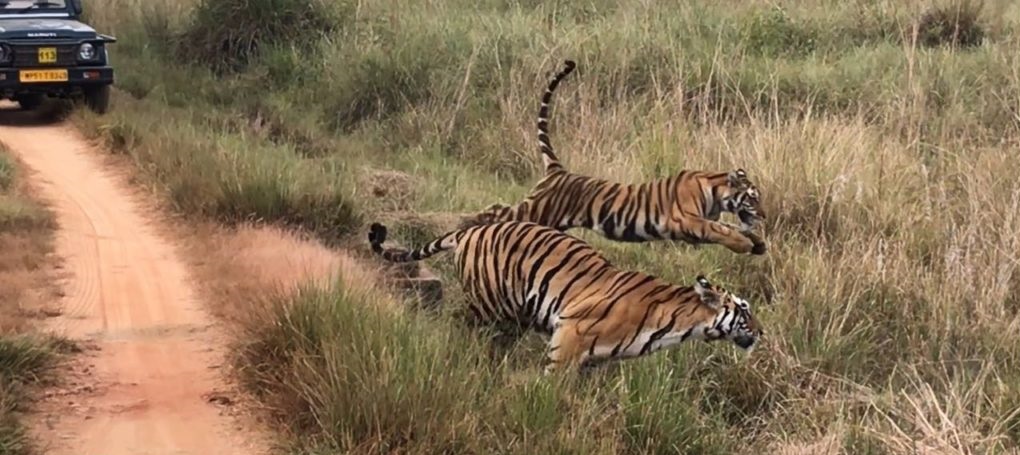Kanha National Park is a realm of mesmerizing natural beauty and abundant wildlife. This pristine wilderness located in the Mandla and Balaghat districts of Madhya Pradesh, is characterised by its lush sal and bamboo forests, expansive meadows, and tranquil water bodies that create a picturesque landscape. The national park's verdant terrain is home to a diverse array of flora and fauna, making it one of the most scenic and biodiverse regions in India. The serene environment is punctuated by the calls of birds and the rustling of leaves, providing a symphony of nature's sounds. Visitors are often captivated by the sight of majestic tigers, graceful deer, and vibrant birdlife amidst the verdant backdrop, making Kanha National Park a true haven for nature lovers and wildlife enthusiasts alike.
In earlier times, the region was under the control of the Gondwana dynasty, with Gond rulers governing a vast area of Central India. This forested area was part of their kingdom, primarily inhabited by tribal communities such as the Gonds and Baigas. Kanha National Park was among the first few national parks selected for Project Tiger at the inception of this conservation effort in India. Today, it is considered one of the well-managed and tourism-friendly national parks in the country. Before its designation as a national park, during British rule, the Maikal-Satpura mountain ranges were home to two notable river valleys: the Halon River Valley and the Banjar River Valley. These valleys, known for their dense forests and rich wildlife, drew attention to conservation efforts during the British period. Recognizing the importance of these forested river valleys, conservation work began, laying the foundation for Kanha's conservation history. The region was initially declared a wildlife sanctuary, later promoted to Kanha National Park, and eventually became the Kanha Tiger Reserve.
Top 3 Facts About Kanha National Park You Will Love to Know
Barasingha: A Great Success Story of Kanha - Swamp deer, also known as Barasinghas, are plentiful in Kanha National Park, often referred to as the "jewel of Kanha." In the past, their beautiful skin and horns made them a target for poachers and hunters. The Barasingha population in the reserve faced significant challenges, but the dedicated efforts of Kanha National Park staff ensured their survival. To protect these deer and other wildlife, the park relocated Gaur to Bandhavgarh and Barasingha to Satpura Tiger Reserve. This initiative successfully introduced at least 500 Barasingha to nine different sites within the reserve.
The Distinct Landscape of Kanha Forest - Tourists will undoubtedly be captivated by the diverse scenery of Kanha National Park. This vast area is home to numerous species of animals and plants, offering beautiful spots to relax and unwind. One of the most magnificent locations in the park is Bamni Dadar, also known as Sunset Point, which is perfect for picnics. The breathtaking view of the setting sun is a must-see, and it’s a fantastic spot for photography. The picturesque charm of the natural reserve is enhanced by the sight of grazing sambar, barking deer, and gaur, adding a magical touch to the landscape. The Kanha region boasts a rich array of flora, with nearly 200 different flowering plants, including prevalent species like Sal, Bija, Lendia, Dhawa, Tendu, Saja, Palas, Mahua, Aonla, Achar, and Bamboo. The presence of these lovely creatures and plant life offers a serene and calming experience.
The Two Rivers of Kanha - The Kanha Tiger Reserve is primarily composed of the Hallon River Valley and the Banjar River Valley. These rivers are crucial to the development of the Kanha Forest, which is home to some of the world's most valuable wildlife. The Banjar Valley lies to the west, while the Hallon River Valley is situated to the east, both traversing the terrain of the Kanha Tiger Reserve.
The Banjar River, a tributary of the Narmada, is considered the lifeblood of KTR as it provides essential water to the rich flora and fauna of Kanha National Park, located on the park's western edge. Flowing through the buffer zone, the Banjar River runs approximately 64 km from the park’s western gate in a northwestern direction.



